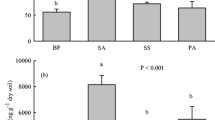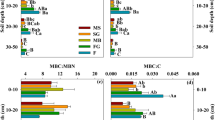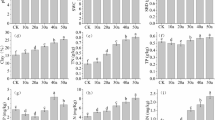Abstract
The relationship between Solidago canadensis L. invasion and soil microbial community diversity including functional and structure diversities was studied across the invasive gradients varying from 0 to 40%, 80%, and 100% coverage of Solidago canadensis L. using sole carbon source utilization profiles analyses, principle component analysis (PCA) and phospholipid fatty acids (PLFA) profiles analyses. The results show the characteristics of soil microbial community functional and structure diversity in invaded soils strongly changed by Solidago canadensis L. invasion. Solidago canadensis L. invasion tended to result in higher substrate richness, and functional diversity. As compared to the native and ecotones, average utilization of specific substrate guilds of soil microbe was the highest in Solidago canadensis L. monoculture. Soil microbial functional diversity in Solidago canadensis L. monoculture was distinctly separated from the native area and the ecotones. Aerobic bacteria, fungi and actinomycetes population significantly increased but anaerobic bacteria decreased in the soil with Solidago canadensis L. monoculture. The ratio of cy19:0 to 18:1ω7 gradually declined but mono/sat and fung/bact PLFAs increased when Solidago canadensis L. became more dominant. The microbial community composition clearly separated the native soil from the invaded soils by PCA analysis, especially 18:1ω7c, 16:1ω7t, 16:1ω5c and 18:2ω6, 9 were present in higher concentrations for exotic soil. In conclusion, Solidago canadensis L. invasion could create better soil conditions by improving soil microbial community structure and functional diversity, which in turn was more conducive to the growth of Solidago canadensis L.
Similar content being viewed by others
References
EHRENFELD J G. Effects of exotic plant invasions on soil nutrient cycling processes [J]. Ecosystems, 2003, 6(6): 503–523.
WOLFE B E, KLIRONOMOS J N. Breaking new ground: Soil communities and exotic plant invasion [J]. Bioscience, 2005, 55(6): 477–487.
CALLAWAY R M, NEWINGHAM B, ZABINSKI C A, MAHALL B E. Compensatory growth and competitive ability of an invasive weed are enhanced by soil fungi and native neighbors [J]. Ecology Letters, 2001, 4(5): 1–5.
CALLAWAY R M, THELEN G C, RODRIGUEZ A, HOLBEN W E. Soil biota and exotic plant invasion [J]. Nature, 2004, 427(6976): 731–733.
KOURTEV P S, EHRENFELD J G, HÄGGBLOM M. Experimental analysis of the effect of exotic and native plant species on the structure and function of soil microbial communities [J]. Soil Biology & Biochemistry, 2003, 35(7): 895–905.
GILLER K, WITTER E, MCGRATH S P. Toxicity of heavy metals to microorganisms and microbial processes in agricultural soils: A review [J]. Soil Biology & Biochemistry, 1998, 30(11/12): 1389–1414.
KHAN S, HESHAM A E L, QIAO Min, HE Ji-zheng. Effects of Cd and Pb on soil microbial community structure and activities [J]. Environmental Science and Pollution Research, 2010, 17(2): 288–296.
WANG Yuan-peng, SHI Ji-yan, WANG Hui, LIN Qi, CHEN Xin-cai, CHEN Ying-xu. The influence of soil heavy metals pollution on soil microbial biomass, enzyme activity, and community composition near a copper smelter [J]. Ecotoxicology and Environmental Safety, 2007, 67(1): 75–81.
FLIESSBACH A, MÄDER P. Carbon source utilization by microbial communities in soils under organic and conventional farming practice [M]// INSAM H, RANGGER A. Microbial communities: Functional versus structural approaches. Berlin, Germany: Springer, 1996: 109–120.
CAI Xing-de, QIU Rong-liang, CHEN Gui-zhu, ZENG Xiao-wen, FANG Xiao-hang. Response of microbial communities to phytoremediation of nickel contaminated soil [J]. Acta Pedologica Sinica, 2006, 43(6): 919–925. (in Chinese)
FROSTEGÅRD A, BÅÅTH E, TUNLID A. Shifts in the structure of soil microbial communities in limed forests as revealed by phospholipids fatty acid analysis [J]. Soil Biology & Biochemistry, 1993, 25(6): 723–730.
WIDMER F A, FLIEBACH E, LACZKO J, ZEYER J. Assessing soil biological characteristics: a comparison of bulk soil community DNA, PLFA, and BIOLOG-analyses [J]. Soil Biology & Biochemistry, 2001, 33(7/8): 1029–1036.
CAMPBELL C D, GRAYSTON S J, HIRST D J. Use of rhizosphere carbon sources in sole carbon source tests to discriminate soil microbial communities [J]. Journal of Microbiological Methods, 1997, 30(1): 33–41.
LIAO Min, XIE Xiao-mei. Effect of heavy metals on substrate utilization pattern, biomass and activity of microbial communities in a reclaimed mining wasteland of red soil area [J]. Ecotoxicology and Environmental Safety, 2007, 66(2): 217–223.
GARLAND J L. Patterns of potential C source utilization by rhizosphere communities [J]. Soil Biology & Biochemistry, 1996, 28(2): 223–230.
LIAO Min, XIE Xiao-mei, MA Ai-li, PENG Ying. Different influences of cadmium on soil microbial activity and structure with Chinese cabbage cultivated and non-cultivated [J]. Journal of Soils and Sediments, 2010, 10(5): 818–826.
ABAYE D A, LAWLOR K, HIRSCH P R, BROOKES P C. Changes in the microbial community of an arable soil caused by long-term metal contamination [J]. European Journal of Soil Science, 2005, 56(1): 93–102.
WENDY M W, DAVID A W. The soil microbial community response when plants are subjected to water stress and defoliation disturbance [J]. Applied Soil Ecology, 2007, 37(1/2): 139–149.
VESTAL J R, WHITE D C. Lipid analysis in microbial ecology [J]. Bioscience, 1989, 39(8): 535–541.
FROSTEGÅRD A, BÅÅTH E. The use of phospholipid fatty acid analysis to estimate bacterial and fungal biomass in soil [J]. Biology and Fertility of Soils, 1996, 22(1/2): 59–65.
KELLY J J, HAÈGGBLOM M, TATE R. L III. Changes in soil microbial communities over time resulting from one time application of zinc: A laboratory microcosm study [J]. Soil Biology & Biochemistry, 1999, 31(10): 1455–1456.
ZHONG Wen-hui, CAI Zu-cong. Long-term effects of inorganic fertilizers on microbial biomass and community functional diversity in a paddy soil derived from quaternary red clay [J]. Applied Soil Ecology, 2007, 36(2/3): 84–91.
LI Wei-hua, ZHANG Cong-bang, GAO Gui-juan, ZAN Qi-jie, YANG Zhong-yi. Relationship between Mikania micrantha invasion and soil microbial biomass, respiration and functional diversity [J]. Plant and Soil, 2007, 296(1/2): 197–207.
GRAYSTON S, GRIFFITH G, MAWDSLEY J, CAMPBELL C, BARDGETT R. Accounting for variability in soil microbial communities of temperate upland grassland ecosystems [J]. Soil Biology & Biochemistry, 2001, 33(4/5): 533–551.
DUDA J J, FREEMAN D C, EMLEN J M, BELNAP J, KITCHEN S G., ZAK J C, SOBEK E, TRACY M, MONTANTE J. Differences in native soil ecology associated with invasion of the exotic annual chenopod, Halogeton glomeratus [J]. Biology and Fertility of Soils, 2003, 38(2): 72–77.
YU Xin-jun, YU Dan, LU Zhi-jun, MA Ke-ping. A new mechanism of invader success: exotic plant inhibits natural vegetation restoration by changing soil microbe community [J]. Chinese Science Bulletin, 2005, 50(11): 1105–1112. (in Chinese)
BOSSIO D A, SCOW K M. Impacts of carbon and flooding on soil microbial communities: Phospholipid fatty acid profiles and substrate utilization patterns [J]. Microbial Ecology, 1998, 35(3): 265–278.
GRIFFITHS B S, RITZ K, WHEATLEY R E. Relationship between functional diversity and genetic diversity in complex microbial communities [M]. INSAM H, RANGGER A. Microbial communities: functional versus structural approaches. Berlin, Germany: Springer, 1997: 1–9.
PÉREZ-PIQUERES A, EDEL-HERMANN V, ALABOUVETTE C, STEINBERG C. Response of soil microbial communities to compost amendments [J]. Soil Biology & Biochemistry, 2006, 38(3): 460–470.
MARSCHNERA P, KANDELERB E, MARSCHNERC B. Structure and function of the soil microbial community in a longterm fertilizer experiment [J]. Soil Biology & Biochemistry, 2003, 35(3): 453–461.
Author information
Authors and Affiliations
Corresponding author
Additional information
Foundation item: Project(2009QNA6015) supported by the Fundamental Research Funds for the Central Universities of China; Project(Y3110055) supported by the Natural Science Foundation of Zhejiang Province, China; Project(Y200803219) supported by the Foundation of Zhejiang Educational Committee of China
Rights and permissions
About this article
Cite this article
Liao, M., Xie, Xm., Peng, Y. et al. Characteristics of soil microbial community functional and structure diversity with coverage of Solidago Canadensis L. J. Cent. South Univ. 20, 749–756 (2013). https://doi.org/10.1007/s11771-013-1544-5
Received:
Accepted:
Published:
Issue Date:
DOI: https://doi.org/10.1007/s11771-013-1544-5




